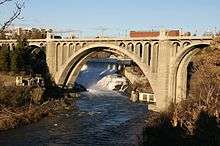Monroe Street Bridge
| Monroe Street Bridge | |
|---|---|
 | |
| Coordinates | 47°39′38″N 117°25′36″W / 47.660539°N 117.426789°WCoordinates: 47°39′38″N 117°25′36″W / 47.660539°N 117.426789°W |
| Crosses | Spokane River |
| Locale | Spokane, Washington |
| Characteristics | |
| Design | Reinforced concrete deck arch bridge |
| Total length | 896 ft (273 m) |
| Width | 50 ft (15 m) wide roadway and 9 ft (2.7 m) wide sidewalks |
| Longest span | 281 ft (85.6 m) |
| History | |
| Opened | 1911 |
 Monroe Street Bridge Location in Washington (state) | |
The Monroe Street Bridge is a deck arch bridge that spans the Spokane River in Spokane, Washington. It was built in 1911 by the city of Spokane and was designed by John Chester Ralston, with ornamentation provided by the firm of Kirtland Kelsey Cutter and Karl Malmgren.[1] At the time of completion it was the largest concrete-arch bridge in the United States and the third longest in the world.
History
The current bridge is actually the third bridge in this location. The first bridge, a rather rickety wooden structure, was built in 1889. That bridge was closed for a time due to arguments in the city over rights of passage and ownership. It burned down in 1890 and was replaced with a steel bridge.
The second bridge vibrated badly and had a noticeable dip in the center. A consultant from the Good Roads Movement considered the bridge unsafe in 1905.[2]
The design of the third bridge was largely copied from the Rocky River Bridge in Cleveland, Ohio, but was built one foot longer to make it the largest concrete arch in the United States at the time. The bridge was designed with ornamental features such as bison skulls, covered pavilions, and a chain-link railing motif. The bison skull was an inspiration of Patrick C. Shine, who had found it in Drumheller, Alberta, Canada, in the early 1900s. The bridge opened in 1911.
20th century modernization
The bridge underwent changes in 1925 and in 1934, and submitted to the modernization of Spokane. The pavilion lamps were converted to electric lighting in 1925, and the electric car railways were removed from the bridge in 1934. The bridge was listed on the National Register of Historic Places in 1975.
21st century restoration
By the 1990s, the bridge had deteriorated to the point where rebuilding it was necessary. In January 2003, the bridge was closed for restoration, dismantled down to the central arch, and rebuilt faithfully to its original appearance. The bridge was reopened in 2005 with new railings and concrete separating the walkways from the road.[3]
References
- ↑ Arksey, Laura (2006). "Spokane's third Monroe Street Bridge, the historic concrete-arch bridge, opens on November 23, 1911.". HistoryLink. Retrieved 2015-02-15.
- ↑ History of the city of Spokane and Spokane County, Washington: from its earliest settlement to the present time by Durham, Nelson Wayne, 1859-1938 https://archive.org/details/historyofcityofs01durh
- ↑ Cannata, Amy (2005). "Nearly a Century Old, the Monroe Street Bridge Reopens This Weekend, Sturdy Enough to Carry Us for the Next 75 Years". Spokane.net. Spokane Spokesman-Review. Archived from the original on 2006-10-10. Retrieved 2015-02-15.
Further Reading
- "Monroe Street Bridge". City-County of Spokane Historic Preservation Office. 2005. Archived from the original on 2006-09-03. Retrieved 2006-09-12.
- Moyano, David C., P.E., S.E., M.ASCE; Shrope, Stephen J., P.E., S.E., M.ASCE (2006). "Past Perfect". Civil Engineering Magazine. American Society of Civil Engineers. Archived from the original on 2006-09-09. Retrieved 2006-09-12.
External links
| Wikimedia Commons has media related to Monroe Street Bridge. |
- Monroe Street bridge, a cold and snowy Sunday, Spokane, Washington
- The Monroe Street bridge, looking to the west from the area of downtown